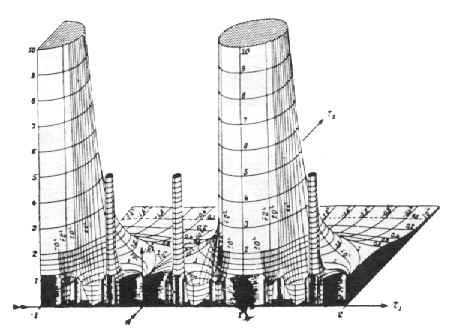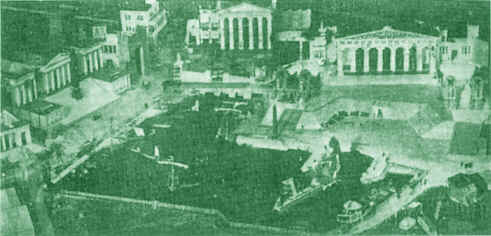|
|
Critique of Urbanism
International Situationniste #6 (August 1961)
Translated by John Shepley
The town of Mourenx. The 12,000 inhabitants are housed in horizontal blocks if they are married, tower blocks if they are single. To the right of the image extends the small neighorhood for middle management, consisting of identical residences sharde equally by two families. Beyond, in the neighborhood for upper management, another type of single-family residence has been created. The management who really control the work done at Lacq live in Pau, Toulouse and Paris.
THE SITUATIONISTS have always said that "unitary urbanism is not a doctrine of urbanism but a critique of urbanism" (Internationale Situationniste 3 [Unitary Urbanism at the End of the 1950s]). The project of a more modern, more progressive urbanism, conceived as a corrective to the present urbanist specialization, is as false as, for example, in the revolutionary project, the overestimation of the moment for seizing power, which is a specialist's idea that immediately involves forgetting, indeed repressing, all the revolutionary tasks posed, at each and every moment, by the whole inseperable combination of human activites. Until it merges with a general revolutionary praxis, urbanism is necessarily the first enemy of all possibilities for human life in our time. It is one of those fragments of social power that claim to represent a coherent whole, and which tend to impose themselves as a total explanation and organization, while doing nothing except to mask the real social totality that has produced them and which they preserve.
By accepting this specialization of urbanism, one puts oneself at the service of the prevailing social and urbanist lie of the State, in order to carry out one of the many possible "practical" urbanisms. But the only practical urbanism for us, the one we call unitary urbanism, is thereby abandoned, since it requires the creation of quite different conditions of life.
Over the past six or eight months, we have seen a number of moves, chiefly among West German architects and capitalists, to launch a "unitary urbanism" immediately, at least in the Ruhr. Some poorly informed entrepeneurs, carried away by thoughts of success, saw fit to announce, in February, the imminent opening of a Unitary Urbanism laboratory in Essen (as a conversion of the Van de Loo art gallery). They published a disgruntled denial only when faced with our threat to reveal publicly the watered-down nature of the plan. The former situationist Constant, whose Dutch collaborators had been excluded from the S.I. for having agreed to build a church, now himself shows factory models in his catalogue published in March by the Municipal Museum in Bochum. This shrewd operator frankly offers himself, along with two or three plagiarized and misconstrued Situationist ideas, as public relations for the integration of the masses into capitalist technological civilization, and reproaches the S.I. for having abandoned his whole program for overturning the urban milieu, he himself being the only one still concerned with it. Under such conditions, yes! Moreover, one might do well to recall that in April 1959 this same group of former members of the Dutch section of the S.I. was firmly opposed to the S.I. adopting an "Appeal to Revolutionary Artists and Intellectuals," and stated: "For us, these perspectives do not depend on a revolutionary overthrow of present-day society, for which the conditions are lacking" (for this debate, see Internationale Situationniste 3, pp. 23 and 24 [Discussion on an Appeal to Revolutionary Intellectuals and Artists]). They have thus continued logically on their path. What is more curious is that there should be people who still try to seduce a few Situationists in order to involve them in this kind of enterprise. Are they betting on the taste for glory or the lure of gain? On April 15, Attila Kotányi replied to a letter from the director of the Bochum museum proposing a collaboration with the Bureau d'Urbanisme Unitaire in Brussels: "If you have some knowledge of the original, we do not think you can confuse our critical view with the apologetic view hidden behind a copy with the same label." And he cut off any further discussion.
 It is not easy to know the Situationist theses on unitary urbanism in their original version. In June, our German comrades published a special issue of their journal (Spur, no. 5), bringing together texts on unitary urbanism over several years in the S.I. or the trends leading to its formation. Many of these texts were unpublished or had appeared in now accessible publications, and none of them had ever been published in German. The measures taken in Germany against the Situationists to prevent the appearance of these texts, or at least to have them altered, were immmediately apparent: from a forced delay of three weeks for the whole edition at the printers to loud threats of prosecution for immorality, pornography, blasphemy, and incitement to riot. The German Situationists have obviously weathered these various attempts at intimidation, and today the managers of respectable unitary urbanism in the Ruhr should begin to wonder if this label is a profitable way to launch their operation. It is not easy to know the Situationist theses on unitary urbanism in their original version. In June, our German comrades published a special issue of their journal (Spur, no. 5), bringing together texts on unitary urbanism over several years in the S.I. or the trends leading to its formation. Many of these texts were unpublished or had appeared in now accessible publications, and none of them had ever been published in German. The measures taken in Germany against the Situationists to prevent the appearance of these texts, or at least to have them altered, were immmediately apparent: from a forced delay of three weeks for the whole edition at the printers to loud threats of prosecution for immorality, pornography, blasphemy, and incitement to riot. The German Situationists have obviously weathered these various attempts at intimidation, and today the managers of respectable unitary urbanism in the Ruhr should begin to wonder if this label is a profitable way to launch their operation.
Confrontation with the whole of present-day society is the sole criterion for a genuine liberation in the field of urban architecture, and the same goes for any other aspect of humanity. Otherwise, "improvement" or "progress" will always be designed to lubricate the system and perfect the conditioning that we must overturn, in urbanism and everywhere else. Henri Lefebvre, in the Revue française de sociologie (no. 3, July-September 1961), criticizes a number of inadequacies in the plan that a team of architects and sociologists have just published in Zurich, Die neue Stadt, eine Studie für das Fürttal. But it seems to us that this criticism does not go far enough, precisely because it does not clearly challenge the actual role of this team of specialists in a social framework whose absurd imperatives it accepts without discussion. This means that Lefebvre's article still valorizes too many works that certainly have their utility and their merits, but in a perspective radically inimical to ours. The title of this article, "Experimental Utopia: For a New Urbanism," already contains the whole ambiguity. For the method of experimental utopia, if it is truly to correspond to its project, must obviously embrace the whole, and carrying it out would lead not to a "new urbanism" but to a new way of life, a new revolutionary praxis. It is also the lack of a connection between the project for an ardent overthrow of architecture and other forms of conditioning, and its rejection in terms of the whole society, that constitutes the weakness of Feuerstein's theses, published in the same issue of the journal of the German section of the S.I., despite the interest of several points, in particular his notion of erratic block, "representing chance and also the smallest organization of objects comprised by an event." Feuerstein's ideas, which follow the S.I. line on "accidental architecture," can only be understood in all their consequences, and carried out precisely by overcoming the separate problem of architecture and the solutions that would be reserved for it in the abstract.
Henceforth the crisis of urbanism is all the more concretely a social and political one, even though today no force born of traditional politics is any longer capable of dealing with it. Medico-sociological banalities on the "pathology of housing projects," the emotional isolation of people who must live in them, or the development of certain extreme reactions of denial, chiefly in young people, simply betray the fact that modern capitalism, the bureaucratic consumer society, is here and there beginning to shape its own environment. This society, with its new towns, is building the sites that accurately represent it, combining the conditions most suitable for its proper functioning, while at the same time translating into spatial terms, in the clear language of the organization of everyday life, its fundamental principle of alienation and constraint. It is likewise here that the new aspects of its crisis will be manifested with the greatest clarity.

Relief representation of the elliptical modular function
In April, a Paris exhibition of urbanism entitled "Tomorrow Paris" offered in reality a defense of large housing complexes, those already built or planned for the far outskirts of the city. The future of Paris would all lie outside of Paris. The first part of this didactic presentation sought to convince the public (mainly working people) that decisive statistics had shown Paris to be more unhealthy and unlivable than any other known capital. They would thus do well to transport themselves elsewhere, and indeed the happy solution was thereupon offered, failing only to mention the now necessary price for the construction of these regroupment zones: for instance, how many years of outright economic slavery the purchase of an apartment in these complexes entails, and what a lifetime of urban seclusion this acquired ownership will come to represent.
Still, the very necessity for this faked propaganda, the need to present this explanation to the interested parties after the administration had quite made up its mind, reveals an initial resistance by the masses. This resistance will need to be sustained and clarified by a revolutionary organization truly determined to know and combat all the conditions of modern capitalsim. Sociological surveys, whose most stultifying defect is to present options only between the dismal variations of what already exists, indicate that 75 percent of the inhabitants of large housing projects dream of owning a house with a garden.
It is this mystic image of ownership, in the old-fashioned sense, that led Renault workers, for example, to buy the small houses that dropped in their laps in June, in a whole quarter of Clamart. It is not by returning to the archaic ideology of a discarded stage of capitalism that the living conditions of a society now becoming totalitarian can ever be truly replaced, rather by freeing an instinct for construction presently repressed in everyone: a liberation that cannot go forward without the other elements in the conquest of an authentic life.
Debates in progressive inquiries today, on politics as well as art or urbanism, lag considerably behind the reality taking shape in all industrialized countries, namely, concentration-camp organization of life.
The degree of conditioning imposed on working people in a suburb like Sarcelles, or still more clearly in a place like Mourenx (a company town in the petrochemical complex of Lacq), prefigures the conditions with which the revolutionary movement will everywhere have to struggle if it is to re-establish itself on a level with the real crises, the real demands of our time. In Brasilia, functional architecture reveals itself to be, when fully developed, the architecture of functionaries, the instrument and microcosm of the bureaucratic Weltanschauung. One can already see that wherever bureaucratic capitalism has already planned and built its environment, the conditioning has been so perfected, the individual's margin of choice reduced to so little, that a practice as essential for it as advertising, which corresponds to a more anarchic stage of competition, tends to disappear in most of its forms and props. You might think that urbanism is capable of merging all former forms of advertising into a single advertisement for itself. The rest will be gotten for nothing. It is also likely that, under these conditions, the political propaganda that has been so strong in the first half of the twentieth century will almost totally disappear, to be replaced by an instinctive aversion for all political issues. Just as the revolutionary movement will have to shift the problem far away from the old field of politics scorned by everyone, the powers that be will rely more on the simple organization of the spectacle of objects of consumption, which will only have consumable value illusorily to the extent to which they will first of all have been objects of spectacle. In Sarcelles or Mourenx, the showrooms of this new world are already being put to the test — atomized to the limit around each television screen, but at the same time extended to cover the whole town.

Decor and its usage. Four historians and many hundreds of millions, it is said, have been employed this year to reconstruct part of the town of Alexandira on a moor in England. It was all for Elizabeth Taylor to play Cleopatra in. The actress falling ill, the film could not be shot, nor the terrain put to further use. Finally Alexandria was delivered to the flames.
If unitary urbanism designates, as we would like it to, a useful hypothesis that would allow present humanity to construct life freely, beginning with its urban environment, it is absolutely pointless to enter into discussion with those who would ask us to what extent it is feasible, concrete, practical, or carved in stone, for the simple reason that nowhere does there exist any theory or practice concerning the creation of cities, or the kind of behaviour that relates to it. No one "does urbanism," in the sense of constructing the milieu required by this doctrine. Nothing exists but a collection of techniques for integrating people (techniques that effectively resolve conflicts while creating others, at present less known but more serious). These techniques are wielded innocently by imbeciles or deliberately by the police. And all the discourses on urbanism are lies, just as obviously as the space organized by urbanism is the very space of the social lie and of fortified exploitation. Those who discourse on the powers of urbanism seek to make people forget that all they are doing is the urbanism of power. Urbanists, who present themselves as the educators of the population, have had to be educated themselves — by this world of alienation that they reproduce and perfect as best they can.
The notion of a center of attraction in the chatter of urbanists is quite the opposite of the reality, exactly as the sociological notion of participation turns out to be. The fact is that there are disciplines that come to terms with a society where participation can only be oriented toward "something in which it is impossible to participate" (point 2 of the Programme Elémentaire) — a society that must impose the need for unappealing objects, and would be unable to tolerate any form of genuine attraction. To understand what sociology never understands, one need only envisage in terms of aggressivity what for sociology is neutral.
The "foundations" in preparation for an experimental life, of which the S.I. program of unitary urbanism speaks, are at the same time the places, the permanent elements of a new kind of revolutionary organization that we believe to be inscribed in the order of the day for the historical period we are entering. These foundations, when they come to exist, cannot be anything but subversive. And the future revolutionary organization will not be able to rely on instruments less complete.
Consumerism and its presentation as spectacle

"But of course. . . they're drinking Cidre Doux"
Within the current framework of consumerist propaganda, the fundamental mystification of advertizing is to associate ideas of fulfillment with objects (televisions, or garden furniture, or automobiles, etc.) and furthermore by destroying the natural link these objects may have with other objects, so as to have them above all become a material environment with "status."
— Editorial Note, Internationale Situationniste #5
|
